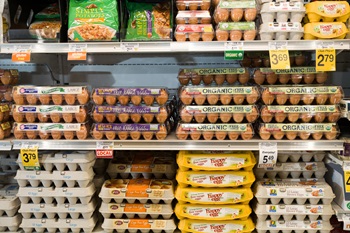By: David Fikes, Vice President, Communications and Consumer/Community Affairs, Food Marketing Institute
 It is the debater’s mantra, define your terms or you will lose the debate. As anyone with any debating experience can attest, the toughest opponent to counter is the one who is allowed to keep changing the terms, reconfiguring the terminology or moving the vocabulary goal posts. This is an important lesson to remember regarding animal welfare issues.
It is the debater’s mantra, define your terms or you will lose the debate. As anyone with any debating experience can attest, the toughest opponent to counter is the one who is allowed to keep changing the terms, reconfiguring the terminology or moving the vocabulary goal posts. This is an important lesson to remember regarding animal welfare issues.
As a means of marking the progress that food companies and retailers are making towards becoming 100 percent cage-free by their target date, Compassion in World Farming (CIWF) has developed the “Egg Track.” Accompanying the “Egg Track” program is a request from CIWF that the top 75 food companies publically share information on an annual basis that discloses the proportion of eggs in their supply chain that are cage-free until they have reached their goal of being 100% cage-free. This could be seen as simply a means of “tracking progress,” but another aspect of this follow-up CIWF campaign is to question the legitimacy of Combination or Combi-systems for laying hens, which feature aspects of both aviaries and conventional cages. This raises concern on two levels: 1) limiting supplier building options and 2) a move to seize control of who defines what cage-free means.
Let’s look at the limiting supplier building option consideration, first; here a bit of background is necessary. Combi-systems are multi-tiered structures with doors - when the doors are closed they offer the benefits of a conventional cage system and when the doors are opened the hens are allowed to roam freely as in a cage-free system. Combi-systems are being offered as a mediating option for suppliers to build, in case the market for cage-free fails to develop. Egg suppliers have been quick to point out that, while retailers may have a “pending market demand” caveat to fall back on in their commitment to be cage-free, suppliers do not have that luxury. They cannot afford to wait to see what happens to the market, but must be building new systems now in order to meet the commitment-driven expectation to be cage-free by 2025. Many are nervously looking at the slow growth in the cage-free category and seriously questioning whether the demand will match the supply. Combi-systems allow for some degree of flexibility to accommodate market demand, but CIWF is challenging the option. It doesn’t take much imagination to figure out why: CIWF and others are seeking to force the market to shape shopper values rather than trusting shopper values to shape the market.
Regarding the second concern, absent a universally accepted definition of cage-free, most retailer commitments to be cage-free did not contain an explicit description or characterization of what that meant. This is an oversight that must quickly be remedied or we risk finding ourselves in the quagmire of shifting definitions. Among others, there are three primary groups whose egg producing standards are used by suppliers; United Egg Producers (UEP), American Humane and Certified Humane. These three sets of standards share a great deal in common, but also differ in a few details.
As the CIWF campaign indicates, retailers need to revisit their public cage-free commitments and define their terms. They also should be having serious conversation about how specific they want or need their definition and supplier requirements to be in order to address company values and customer expectations.
You can access more resources on cage-free eggs at FMI.org.

 Industry Topics address your specific area of expertise with resources, reports, events and more.
Industry Topics address your specific area of expertise with resources, reports, events and more.
 Our Research covers consumer behavior and retail operation benchmarks so you can make informed business decisions.
Our Research covers consumer behavior and retail operation benchmarks so you can make informed business decisions.
 Events and Education including online and in-person help you advance your food retail career.
Events and Education including online and in-person help you advance your food retail career.
 Food Safety training, resources and guidance that help you create a company food safety culture.
Food Safety training, resources and guidance that help you create a company food safety culture.
 Government Affairs work — federal and state — on the latest food industry policy, regulatory and legislative issues.
Government Affairs work — federal and state — on the latest food industry policy, regulatory and legislative issues.
 Get Involved. From industry awards to newsletters and committees, these resources help you take advantage of your membership.
Get Involved. From industry awards to newsletters and committees, these resources help you take advantage of your membership.
 Best practices, guidance documents, infographics, signage and more for the food industry on the COVID-19 pandemic.
Best practices, guidance documents, infographics, signage and more for the food industry on the COVID-19 pandemic.
